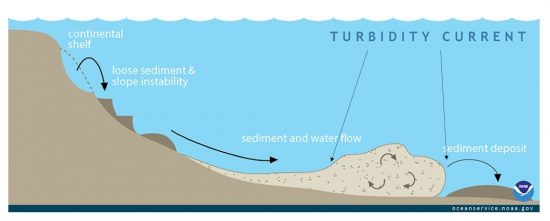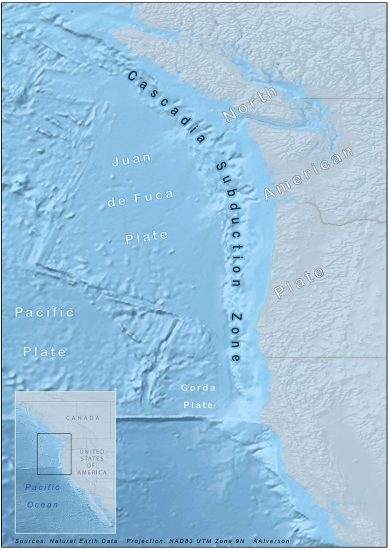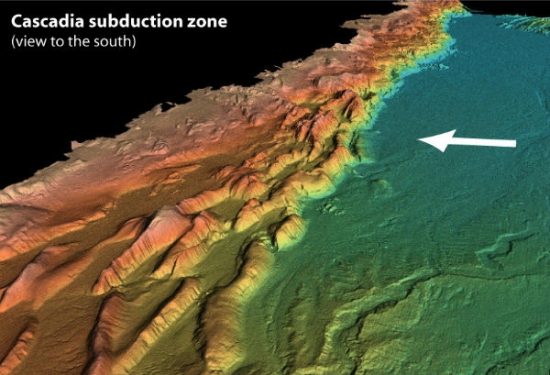




Researchers have discovered that large earthquakes can trigger underwater landslides thousands of miles away weeks or months after the occurrence of the event.
After analyzing data from ocean bottom seismometers off the Washington-Oregon coast, researchers were able to link a series of underwater landslides on the Cascadia Subduction Zone to a 2012 earthquake in the Indian Ocean – more than 13,500 kilometers away. These underwater landslides had occurred intermittently for almost four months after the magnitude-8.6 earthquake.
It has been proved that earthquakes can trigger additional earthquakes on other faults, the new study shows that it can also trigger underwater landslides some distance away from the quake.
The new study has been published in the Journal of Geophysical Research: Solid Earth. Lead author Paul Johnson, an oceanographer at the University of Washington in Seattle, said, “The basic assumption ... is that these marine landslides are generated by the local earthquakes. But what our paper said is, ‘No, you can generate them from earthquakes anywhere on the globe."
The findings may complicate sediment records used to estimate earthquake risk. If underwater landslides could be triggered by earthquakes far away – and not just ones close by – scientists would need to determine if a local or distant earthquake generated the deposits before using them to date local events and estimate earthquake risk, said the study’s authors.
The submarine landslides in the study are smaller and more localized than widespread landslides generated by a great earthquake directly on the Cascadia margin itself. However, according to the study’s authors, these underwater landslides generated by distant earthquakes may cause local tsunamis and damage underwater communications cables.
The team had discovered that Cascadia landslides were caused by a distant earthquake by accident. They had placed ocean bottom seismometers off the Washington-Oregon coast to detect tiny earthquakes, and to measure ocean temperature and pressure at the same locations. When Johnson learnt about the seismometers at a scientific meeting, he decided to analyze the data they had collected to see if he could detect any evidence of thermal processes affecting seafloor temperatures.
He and his team combined the seafloor temperature data with pressure and seismometer data and video stills of sediment-covered instruments from 2011 to 2015. Small temperature variations had occurred for several months, followed by temperature spikes over two to 10 days. They concluded these temperature changes were signs of multiple underwater landslides that deposited sediments into the water.
These landslides caused warm, shallow water to become denser and flow downhill along the Cascadia margin, after the 8.6-magnitude Indian Ocean earthquake on 11 April 2012, causing the temperature spikes.
The Cascadia margin runs for more than 1,100 kilometers off the Pacific Northwest coastline, encompassing the area above the underlying subduction zone, where one tectonic plate slides beneath another.
Steep underwater slopes hundreds of feet high line the margin. Sediment accumulates on the top of these slopes. When the seismic waves from the Indian Ocean earthquake reached the slopes, they jostled the thick sediments on top, causing areas of sediment to break off and slide down the slope. This created landslides along the slope. As the sediment did not fall all at once, the landslides continued to occur for up to four months after the earthquake.
The steeper-than-normal slopes off the Washington-Oregon coast (like those of Quinault Canyon, which descends 1,420 meters at up to 40-degree angles), make the area susceptible to submarine landslides. The thick sediment deposits also amplify seismic waves from distant earthquakes. Small sediment particles move like ripples suspended in fluid, amplifying the waves.
Referring to these, Johnson said, “So these things are all primed, ready to collapse, if there is an earthquake somewhere.”
The study’s authors added that the new finding could have implications for tsunamis in the region and may complicate estimations of earthquake risk.
Subduction zones like the Cascadia margin are vulnerable to tsunamis. As a tectonic plate slides under another, they become locked together, storing energy. When the plates finally slip, energy is released, causing an earthquake. If there is any water under the fault, this sudden motion gives any water above it an upward shove, and this lowers the coastal land beside it as the overlying plate flattens out. This causes the shoreline to be more vulnerable to waves of displaced water.
According to Johnson, submarine landslides increase this risk, by pushing ocean water out of the water when they occur.
The risk of earthquakes can be estimated using underwater sediment. Scientists can use sediment cores extracted offshore to obtain a timeline of past earthquakes, which can be used to predict the frequency and intensity of future earthquakes.
An earthquake off the Pacific Northwest would create submarine landslides all along the coast from British Columbia to California. But the new study found that a distant earthquake might only result in landslides up to 20 or 30 kilometers wide. That means when scientists take sediment cores to determine how frequent local earthquakes occur, they may not be able to tell if the sediment layers arrived on the seafloor as a result of a distant or local earthquake.
According to Johnson, more core sampling over a wider area would be needed to get a more accurate reading of the geologic record and to update estimates of earthquake risk.
 Herbert
Herbert 5th July 2017
5th July 2017